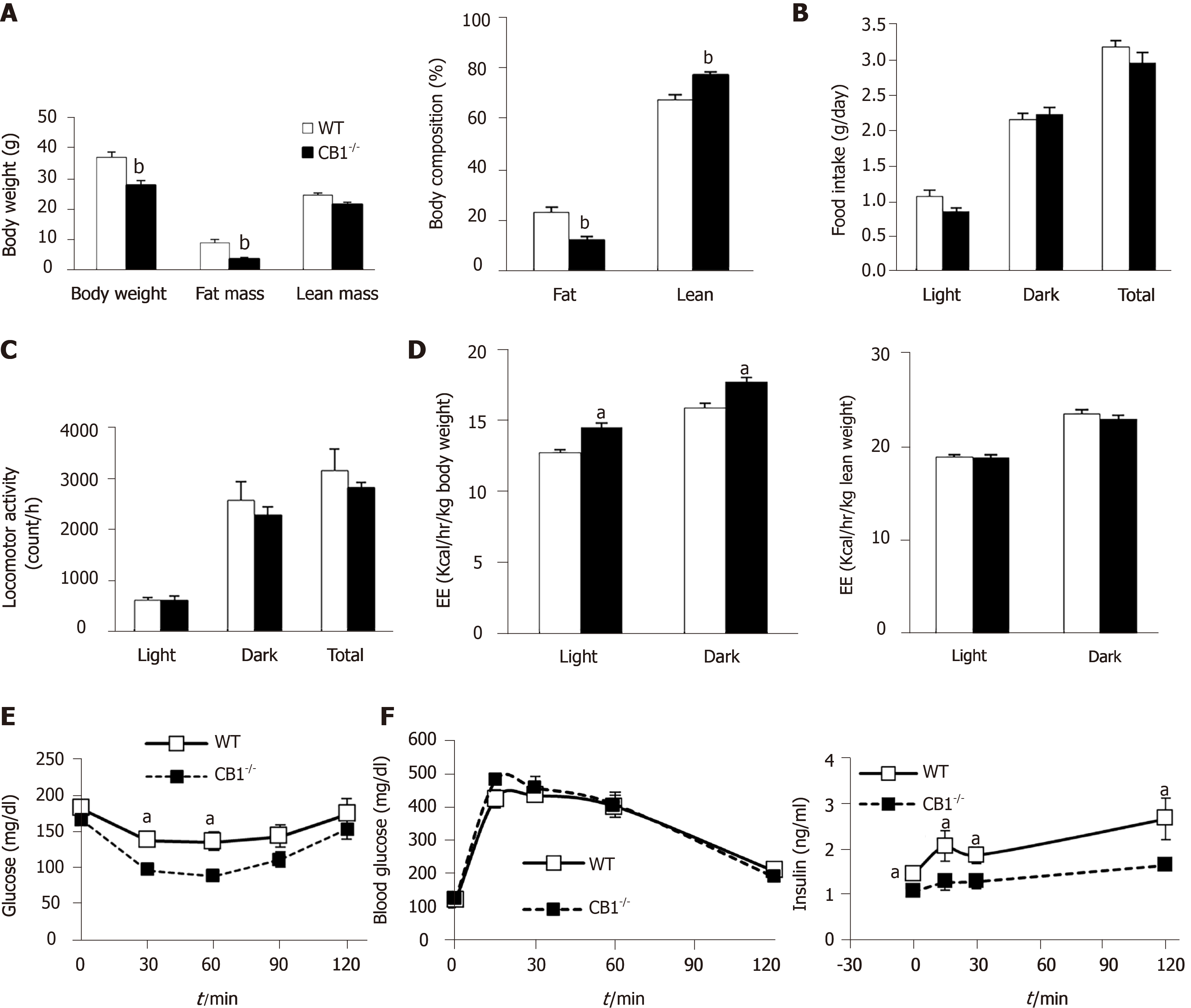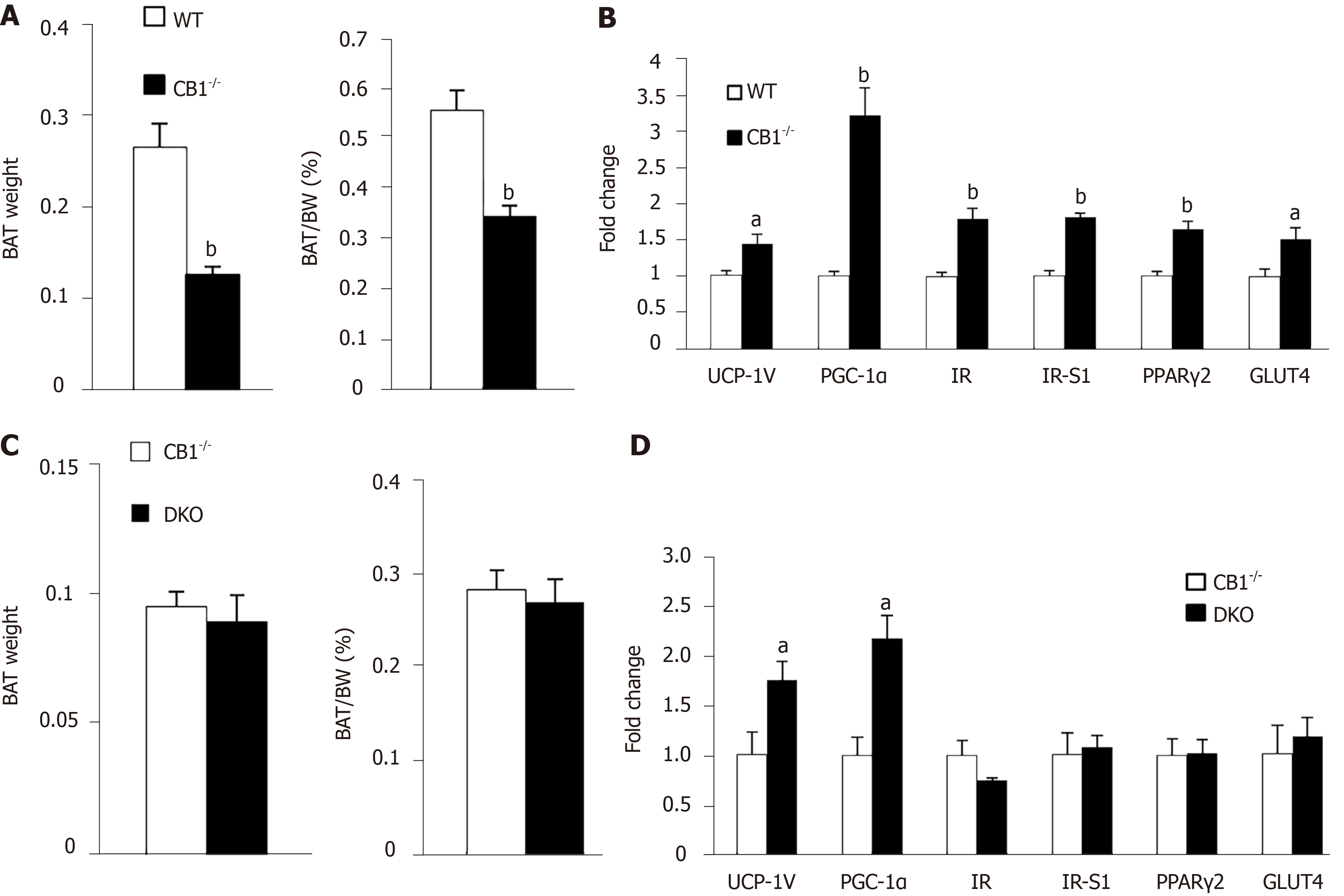Copyright
©The Author(s) 2021.
World J Diabetes. Oct 15, 2021; 12(10): 1750-1764
Published online Oct 15, 2021. doi: 10.4239/wjd.v12.i10.1750
Published online Oct 15, 2021. doi: 10.4239/wjd.v12.i10.1750
Figure 1 Cannabinoid type 1 receptor-null mice have reduced adiposity and improved insulin sensitivity.
Wild-type (WT) and cannabinoid type 1 receptor-null (CB1-/-) male mice at 4 mo of age. A: Body weight and body composition; B: Daily food intake; C: Locomotor activity; D: Energy expenditure adjusted by body weight or lean mass; E: Insulin tolerance tests; F: Glucose tolerance tests at 5 mo of age. n = 5-7. aP < 0.05, bP < 0.001, WT vs CB1-/-.
Figure 2 Cannabinoid type 1 receptor-null mice have similar adiposity and insulin sensitivity compared to double-knockout mice.
Cannabinoid type 1 receptor-null (CB1-/-) and double-knockout (DKO) male mice at 4 mo of age. A: Body weight and body composition; B: Daily food intake; C: Locomotor activity; D: Energy expenditure adjusted by body weight or lean mass; E: Insulin tolerance tests; F: Glucose tolerance tests at 5 mo of age. n = 5-7. aP < 0.05, CB1-/- vs DKO.
Figure 3 Double-knockout mice have similar expression of thermogenic genes compare to cannabinoid type 1 receptor-null mice.
Wild-type (WT) and cannabinoid type 1 receptor-null (CB1-/-) male mice at 8 mo of age. A: Brown adipose tissue (BAT) weight and percentage of BAT depot; B: Quantitative real-time RT-PCR analysis of gene expression in BAT. Cannabinoid type 1 receptor-null (CB1-/-) and double-knockout (DKO) male mice at 8 mo of age. C: BAT weight and percentage of BAT depot; D: Quantitative real-time RT-PCR analysis of gene expression in BAT. n = 6-8. aP < 0.05, bP < 0.001, WT vs CB1-/- or CB1-/- vs DKO.
Figure 4 Cannabinoid type 1 receptor-null mice have reduced peritoneal and adipose tissue inflammation.
Wild-type (WT) and cannabinoid type 1 receptor-null (CB1-/-) male mice at 8 mo of age. A: Flow cytometry analysis of M1 and M2 in peritoneal macrophages; B: Percentage of epididymal fat depot; C: Flow cytometry analysis of M1 and M2 in epididymal fat; D: Pro-inflammatory cytokines expression in epididymal fat. n = 6-8. aP < 0.05, bP<0.001, WT vs CB1-/- mice.
Figure 5 Double-knockout mice have increased peritoneal and adipose tissue inflammation compared to cannabinoid type 1 receptor-null mice.
Cannabinoid type 1 receptor-null (CB1-/-) and double-knockout (DKO) male mice at 7 mo of age. A: Flow cytometry analysis of M1 and M2 macrophages of peritoneal macrophages; B: Epididymal weight and percentage of epididymal depot; C: Flow cytometry analysis of M1 and M2 in stromal vascular fraction of epididymal fat; D: Pro-inflammatory cytokines expression of epididymal fat. n = 6-7. aP < 0.05, bP < 0.001, CB1-/- vs DKO mice.
Figure 6 Schematic diagram of summary.
Cannabinoid type 1 receptor (CB1) utilizes differential mechanisms in control of metabolism and inflammation. A: CB1 decreases thermogenesis in BAT through sympathetic nerve activity to reduce energy expenditure and adiposity. So the effect of CB1 on metabolism is adiponectin-independent; B: CB1 suppresses adiponectin in adipose tissue, which diminishes the anti-inflammatory effect of adiponectin, thus promoting macrophage pro-inflammatory polarization. So the effect of CB1 on inflammation is adiponectin-dependent. Thus, CB1 utilizes differential mechanisms in control of metabolism and inflammation: its effect on metabolism is adiponectin-independent while effects on inflammation are adiponectin-dependent. Thus, adiponectin is not required for CB1-mediated metabolism, but is required for CB1-mediated inflammation.
- Citation: Wei Q, Lee JH, Wu CS, Zang QS, Guo S, Lu HC, Sun Y. Metabolic and inflammatory functions of cannabinoid receptor type 1 are differentially modulated by adiponectin. World J Diabetes 2021; 12(10): 1750-1764
- URL: https://www.wjgnet.com/1948-9358/full/v12/i10/1750.htm
- DOI: https://dx.doi.org/10.4239/wjd.v12.i10.1750














